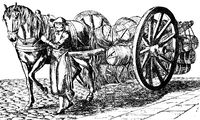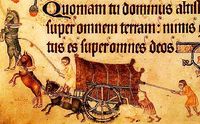The development of the public services infrastructure in Ewyas Lacy is, naturally enough, closely linked to the development of the communities in the area. In the early days of settlement the rudiments of a transport network began to emerge first, though in a time of subsistence farming most travel was in the immediate area on foot or horseback across open land. This created the forerunners of later footpaths and lanes, many of which still remain, linking farms, churches and inns. As settlements grew and prospered, the need for transport of heavy materials for building began to create a need for hard surfaced roads to and from quarry sites. Later, as agriculture became more sophisticated, corn mills became another focus for the development of local roads to permit grain to be carted in and flour out. By the 19th century, the growth of trade and the need to take produce to market provided further impetus to road building, and the inexorable rise of motor vehicles in the 20th century completed the transition to the modern transport network.
Other modern public services were slow to follow, in part because of the remoteness of the area and the low population density. In most parts of Ewyas Lacy springs and brooks provided plenty of water so there was little call for public supply. Likewise, farming tends to follow daylight hours so a combination of high access costs and low demand meant that grid electricity did not reach parts of the area until the 1960s; oil lamps and sometimes diesel generators provided light, and the watermill at Clodock operated a turbine that was used to charge accumulators for those within easy reach.
| |






